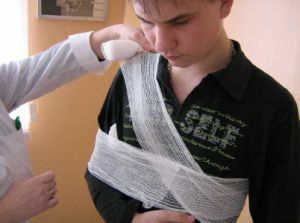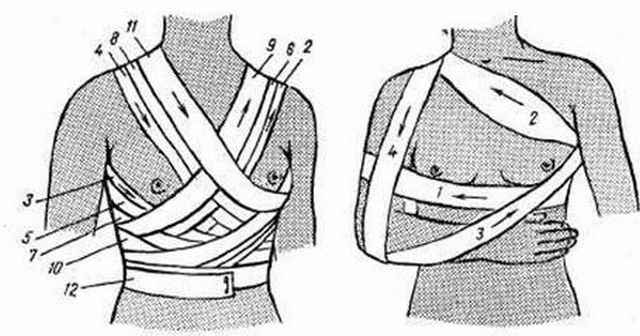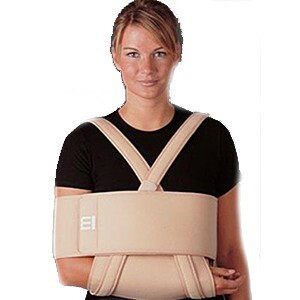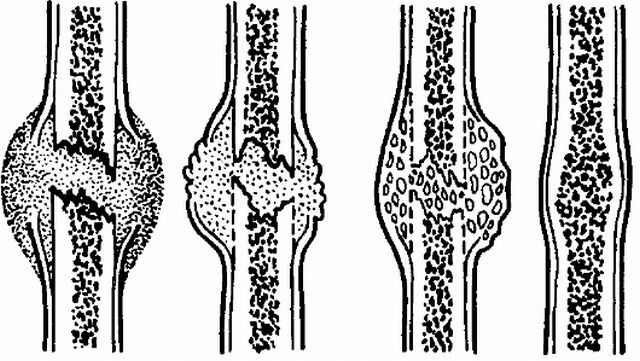 In the provision of emergency medical care or treatment of a patient, not only medicines are used, but also devices that facilitate the general condition of the victim and contribute to an early recovery.
In the provision of emergency medical care or treatment of a patient, not only medicines are used, but also devices that facilitate the general condition of the victim and contribute to an early recovery.
Most of these additional devices are used by medical personnel, as well as civilians at home.
In the traumatological and orthopedic departments of any medical institution with minor fractures or bruises, specialists often use the so-called Dezo bandage, which performs the fixing function.
Contents of the article
- Using a dressing
- Methods for grooming
- How to properly immobilize?
- Who can apply a bandage other than a doctor?
- Alternative bondage
- Indications for the use of ready-made dressings
- As a conclusion
Use of a bandage
An immobilizing bandage made of bandage was developed and introduced by the French traumatologist of the XVIII century - Pierre Desot. Bandage bandage is still used in surgery, orthopedics and traumatology. Of course, the French specialist of that time became famous not only for this invention, but his name is inextricably linked with this bandage.
In other words, with the bandage, the affected shoulder and forearm are fixed to the body.
The dressing is actively used to fix the limb after a serious operation and during the rehabilitation period.
This technique to this day allows you to locate as close as possible the broken( broken off) element of the clavicle to the main group of bones.
It is understood that this way of fixing the affected limbs can be used only with simple, simple damages( fractures).
To apply a bandage, you need a medical bandage( 5 meters long and 20-25 cm wide) and 2-3 conventional pins.
There are no contraindications, the main thing is to know how to impose a bandage.
Methods of grooming
It should be remembered such points:
- dressing can be washed in water at room temperature;
- use of hot water in washing is unacceptable, since the bandage can deform and lose its size( it will decrease or stretch);
- is allowed to use dry cleaning agents( gels and powders), but the use of bleach is contraindicated;
- Deso dressing drying occurs only under direct sunlight and preferably indoors.
The bandage is recommended only with the permission of the attending physician. It is not recommended to buy a dressing in a pharmacy without fitting yourself.
If you know your size( height, chest volume), then on the package there is a detailed instruction with the size.
How to properly immobilize?
Having ascertained, when the Dezo bandage is applied, we will consider what the banding technique should be in a particular case. 
Before placing a bandage, the hand is given a natural position.
To begin with, the medical worker( doctor, paramedic or nurse) fixes the shoulder to the body, then the wrist is fixed, and in the end - the radial joint from the injured side.
The joints of the intact arm are left loose so that the patient can use a healthy limb.
Of the equipment will need:
- medical bandage( width 20-25 cm);
- roller made of cotton wool and or gauze;
- ordinary scissors;
- two pins and antiallergenic adhesive plaster.
When the bandage is applied to the right hand, the bandage tours start from right to left and vice versa. The injured upper limb is given a bent position at an angle of 90 °.
Algorithm for dressing the dezo:
- The first round of the ( the turn of the bandage around the body or limb).The bandage is imposed only after the patient is put a cotton or gauze roll into the armpit. Then you need to gently bend the damaged arm at an angle, bend at the elbow and press it against the chest. Only after this procedure can proceed with further manipulation.
- Next do second round of .The doctor leads the bandage from behind, from the axillary zone, not the injured side, to the injured forearm.
- The third round of the is a continuation of the previous one. From the forearm, the bandage is guided along the shoulder side from behind, then below the forearm of the injured upper limb, in order to direct the bandage to the healthy axillary region. Further we direct on the back to the shoulder of the injured hand.
- The fourth round of the involves dropping the bandage shoulder from the front, covering the elbow of the injured limb, then proceeding along the back to the armpit.
- Further application of the bandage implies the repetition of the above manipulations( except the first round) three times. Three times the second, then the third and fourth tours are repeated, it is important not to confuse.
If the Dezo bandage is planned to be applied over a long period of time, the tours can be strengthened by sewing them with a normal thread.

On the photo of the dressing technique of the dezo dressing
After the repetitions we finish applying the bandage with the last circular stage. Bandage is spent around the sternum of the patient.
After that the edge of the bandage is healed by previously prepared pins, the excess edge of the bandage is cut off. In principle, the bandage of the French surgeon is ready. If the injury requires a long fixation of the patient's hand, then there is the option of using gypsum.
Who can apply a bandage other than a doctor?
A bandage of this type can be imposed by a person who is not a medical employee and has never studied it. But to successfully carry out this manipulation is not enough just to know the theory.
We need constant practical exercises, it is recommended to watch video courses about how the Dezo bandage is applied to injured parts of the body.
Alternative bondage
It should be noted that to date people who do not have a medical education do not necessarily need to study the technique of applying the Dezo dressing in detail.
Literally two years ago, a bandage was invented, which corresponded to the ready-made bandage of Deso. In principle, this is the same bandage, only it is already in the ready version - it is whole and ready for use.
 Such bandages are made of cottons, polyester and latex. This type of bandage has a convenient velcro fastener. A ready-made dressing reliably fixes the desired limb, providing comfortable conditions for the patient.
Such bandages are made of cottons, polyester and latex. This type of bandage has a convenient velcro fastener. A ready-made dressing reliably fixes the desired limb, providing comfortable conditions for the patient.
The dressing material is able to warm the injured area of the and is suitable, either under the right or under the left limb.
As for the cost, the price for such a convenient invention is quite affordable. The process of applying a ready bandage is much faster and more convenient than using a medical bandage.
Indications for use of ready-made dressings
This type of bandage is sold in every pharmacy and in the Internet:
Suitable for:
- immobilization of hands and shoulder joint post-operation period;
- slight injuries of the clavicle, elbow and shoulder joints, bruised arm, dislocated shoulder;
- is prescribed for arthritis of the joints of the hands, arthrosis;
- cuts and other minor hand injuries;
- rehabilitation measures after light fractures of the upper limbs and scapula.
 What operations are used to cure the habitual dislocation of the shoulder? Reviews about various methods of surgical intervention.
What operations are used to cure the habitual dislocation of the shoulder? Reviews about various methods of surgical intervention.
Disturbance of the tubular bone with the appearance of mobility in uncharacteristic parts or a false joint. What can be caused by pathology?
As a conclusion
It is desirable that the acquired knowledge during training and training is never useful. But, the probability of someone providing emergency first aid in the absence of a specialist still exists.
And, perhaps, this skill will someday save someone's life. Overlaying the Dezo bandage is a simple and understandable process, available to absolutely anyone with the desire to learn.
And the last tip, if you do not have enough knowledge and experience, then the dressing of the bandage is best entrusted to specialists. This will help to avoid further complications.



